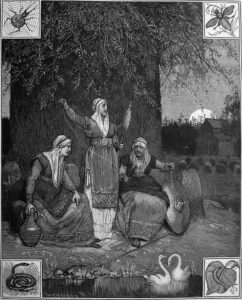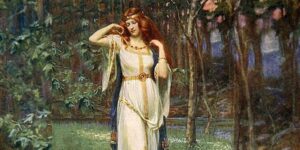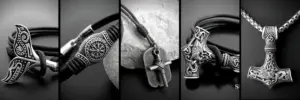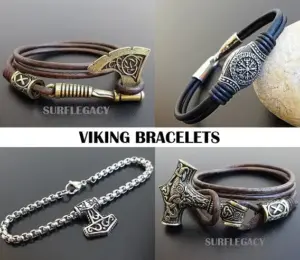Seidr (pronounced “SAY-der”) was a form of ancient Norse magic and shamanism that was an integral part of pre-Christian Norse spirituality and society.
Evolving from even older Germanic and circumpolar Eurasian shamanic traditions, seiðr incorporated divination, spellcasting, blessings, curses, spirit contact, altering fate, and other facets of magic.
Seiðr practitioners, who were predominantly women known as vǫlur, served important roles in their communities as shamans, healers, seers, and wielders of supernatural power tied to the complex Norse cosmology.
The nature and origins of seiðr have been widely studied since the medieval period, with renewed academic interest as its practices have been revived and reinterpreted by modern pagan practitioners.
Exploring the practice of seidr unveils profound insights into the metaphysical worldview and spiritual customs of the ancient Norse people.
Etymology and Terminology
In Old Norse, the term seiðr meant ‘cord, string, snare, knot magic’ and could refer to the act of performing magic or to magic arts in general.
The exact etymology is debated, but it may derive from the Proto-Germanic *saiðaz, meaning ‘cord, string’, stemming from the Proto-Indo-European root *seH2i- ‘to bind’.
This likely referenced binding runes carved onto staves, pieces of bark, or other objects used in spells and charms. Other possibilities link seiðr to Proto-Celtic words like *soito- denoting ‘sorcery’.
Related terms in Old English included siden and sidsa, used in contexts suggesting associations with elves and meaning something similar to seiðr.
The Old Norse seiðkona referred specifically to a female practitioner, while seiðmaðr denoted a male practitioner.
The distaff, a staff used in spinning fibers, was another tool linked to seiðr practice, symbolically tied to the ‘threads’ of fate. In contrast, the related Finnish word seita and Sami term sieidde denoted sacred sites and objects rather than magical arts specifically.
Practitioners and Methods
Seiðr practitioners were mostly women, known as vǫlur (often translated as ‘seeresses’ or ‘sibyls’). The vǫlva was a highly respected and feared figure who used divination, runic magic, spirit contact, and charms to serve her community.
She presided over ceremonies, performed blessings, gave counsel, cured diseases, cursed enemies if need be, and harnessed supernatural power through her connection to the spirit realm.
Vǫlur employed various ritual methods to achieve trance states and work their magic. This included fasting, sensory deprivation, chanting, drumming, dancing, ritual costume, staffs, jewelry, and sometimes hallucinogenic plants and fungi.
Their elaborate clothing, jewelry, and tools reflected their mystical vocation. Once in a trance state, their spirit could journey between worlds to gather occult knowledge and work spells.
Male seiðr practitioners were known as seiðmenn, though they were rarer. Men performing magic were disparaged as unmanly (ergi) and could face social stigma.
Yet mythic figures like Odin practiced seiðr, and some historical men likely did too. They may have operated in secret or under a vǫlva’s guidance. Some nobles and rulers possibly employed male practitioners as spies or counselors leveraging seiðr’s power over minds.
Seidr Practices and Norse Cosmology
Various sources describe seiðr practices of divination, clairvoyance, blessing, cursing, healing, weather control, finding lost objects or people, warding off evil spirits, inducing forgetfulness or insanity, shapeshifting, necromancy, and manipulation of Wyrd – the web of fate governing the Nine Worlds.
Discovering and altering Wyrd, which even the gods were subject to, was among seiðr’s greatest powers.
The cosmic Wyrd was established by the Norns (Fates), but its threads could be divined and re-weaved by gods, spirits, and skilled mortals through seiðr. This underlies how seiðr practices sought to discern and influence events and destinies.

The Norns weaving the tapestry of fate
By traveling spiritually along Wyrd’s strands, vǫlur could discover knowledge and prophesy, heal by restoring lost soul parts, curse by severing or tangling fate-lines, stir up or calm storms, ensure bountiful hunts and harvests by realigning Nature’s wyrd, gain hidden wisdom, and wield tremendous power subject to Wyrd’s greater pattern.
Wider Norse cosmology, encompassing the Nine Worlds connected by Yggdrasil, is key to understanding seiðr practices reliant on spirit travel and traffic between worlds.
The vǫlva traversed Yggdrasil’s realms and overcame spirits guarding knowledge while in trance. Concepts of the soul, including the hugr (consciousness), hamr (shape), and fylgja (fetch), also explain seiðr techniques of projection, shapeshifting, and consulting ancestor spirits.
Seidr vs Galdr
Seidr and Galdr, two distinct forms of magic in Norse tradition, exhibit differences in techniques, purposes, and associations, offering unique insights into the spiritual beliefs of the Vikings.
Seidr involves altered states of consciousness, fate manipulation, divination, and healing. Female practitioners, known as völvas or seiðkonur, are closely associated with Seidr, aligning with the realms of the god Odin and goddess Freyja. Its focus lies in accessing hidden realms and manipulating the threads of fate.
On the other hand, Galdr, associated with male practitioners but open to women as well, centers on runes, incantations, and chants. The recitation of runic formulas or verses, often in poetic stanzas or songs, aims to invoke specific effects like protection, healing, power increase, or weather control.
The divergence between Seidr and Galdr extends to their core methodologies—Seidr emphasizes altered states of consciousness and trance, fostering communication with various beings, while Galdr relies on the symbolic power of runes and incantations.
The use of language, sound, and symbolism is paramount in Galdr, reflecting the importance of these elements in Norse magical practices. Despite these distinctions, Seidr and Galdr share common ground.
Both were integral to Viking spiritual beliefs and played significant roles in society. Practitioners of both forms navigated the complex social dynamics surrounding magic in Viking society, earning respect and possibly fear for their knowledge and abilities.
Table Comparing Seiðr and Galdr:
| Seiðr | Galdr | |
|---|---|---|
| Focus | Shamanic, ecstatic, trance journeys | Runic incantations, chants, songs |
| Practitioners | Predominantly women (vǫlur) | Men and women (galdrakona, galdrar-mann) |
| Cosmological Role | Unveiling and reweaving fate’s hidden strands | Harnessing runic potency to reshape fate’s flow |
| Ritual Methods | Drumming, dancing, costume, psychoactive plants | Runestaves, written charms, spoken spells |
| Mythic Associations | Freyja, Norns, Odin | Odin, Thor |
| Social Factors | Ambivalent status, ergi stigma for men | More accepted for men, but still liminal |
Seidr in Norse Mythology
In Norse myth, the goddess Freyja first brings seiðr to the Æsir, having practiced it among her ancestral Vanir. A master sorceress, she teaches Odin who integrates it into his quest for wisdom. According to the Ynglinga Saga, seiðr includes prophecy and sorcery.

Freyja by James Doyle Penrose, 1890 Public Domain
In the Poetic Edda poem Lokasenna, Loki derides Odin for practicing women’s magic, violating masculine norms. But Odin’s preparedness to sacrifice social position for occult power highlights seiðr’s immense potential. Mythic accounts show Odin consulting vǫlur to see the future, especially in the Völuspá where a völva recounts Norse cosmogony and the Apocalypse after Odin works charms to revive and compel her.
The vǫlva Thórbjörg lítilvölva in the Saga of Erik the Red is described wearing an intricate blue cloak with a black hood adorned with feline trim. She holds a ceremonial staff, sits on an elevated platform, and chants spells, aligning with findings from archaeological evidence.
Seiðr also appears in sagas when practitioners bless or curse protagonists, showcasing its influence. The witch Gróa tries unsuccessfully to aid Thor through magic learned from her vǫlva mother in Svipdagsmál.
Seidr in Viking Society
In Norse communities, seiðr was an esoteric yet socially embedded practice tied to group welfare and cosmic forces governing life. Vǫlur served as shamans, healers, and proto-priestesses in their locales.
People sought their wisdom for divination, blessings, curses, fertility magic, defense against spirits, and remedies for ailments. The vǫlva’s spirit travels to hidden worlds paralleled Odin’s quests, reflecting her mythic connections.
Leaders also employed vǫlur to reinforce claims to power and provide military intelligence from their transcendent vantage.
However, seiðr’s perceived power made vǫlur both respected and feared. Unprincipled use of curses and sorcery, which could backfire via wyrd’s feedback, produced ambivalence.
Although integral to pagan Norse life, vǫlur stood apart as liminal guardians of archaic mysteries.
For men, performing seiðr challenged Nordic masculine ideals, risking accusations of ergi. Yet traces of male practitioners imply magico-religious authority outweighed such perils for some.
Vǫlur may have passed teachings to sons as well. While subject to complex social regulations, seiðr served vital purposes from the level of individuals to entire communities in the Viking Age.
Seidr Origins and External Influences
The origins of seiðr are likely quite ancient, perhaps stemming from circumpolar Eurasian shamanic practices diffused southward into Germanic and Norse proto-cultures.
Archaeological evidence clearly demonstrates a long tradition of shamanic religion across northern Eurasia pre-dating the Viking Age.
Elements like drumming, chanting, bone fragments in graves, and ritual costumes bear strong shamanic markers.
The interaction of Norse settlers with Sámi and Finnic groups from the 5th century onwards seems to have infused syncretic circumpolar elements into Odinic and Vanic seiðr customs. But how far back seiðr’s roots reach remains opaque.
Medieval accounts were colored by Christianization, yet modern archaeology and surviving folk practices provide clues to recover a clearer picture. Comparative Sámi ethnography also helps decode what was lost in translation or deliberate distortion.
For instance, grave remains marking the burial of a volva with wand and ritual accouterments counter biases in the textual history. Nonetheless, inconsistencies among accounts indicate the diversity of seiðr practices across Scandinavia. More extreme aspects may reflect deeper circumpolar influences in Norse-Sámi border regions.
Locating seidr in both its embedded roles within Old Norse society as well as its connections to a broader Eurasian shamanic heritage enables a balanced perspective.
It occupied a complex nexus of religion, magic, gender, social norms, cultural contact, and links between the seen and unseen realms.
As the Viking Age gave way to Christianization, seidr faded but did not vanish entirely. Fragments persisted as folk practices through the centuries, laying the foundations for its modern rediscovery.
Revival and Reinterpretations
Today there is heightened interest in reviving seidr practices among Germanic Neopagan groups and individuals seeking to reconnect to Norse heritage and cosmology.
However, effectively reconstructing seidr poses challenges due to limitations in medieval accounts and extensive cultural changes.
Much seidr lore was lost in the transition to Christianity. Yet some have attempted to resurrect seidr by reference to such records and later folk practices as do survive, whether accurately or not.
Contemporary practitioners often maintain seidr’s oneiric and visionary aspects but may avoid or alter more controversial facets tied to animal sacrifice and intoxicants.
Academics studying the phenomenon discern practices like chanting and shamanic drumming do likely represent authentic Norse ritual methods, if diverging from exact pre-Christian forms. Individual experiences understandably take precedence over precise reconstruction for modern adherents.
Respectful acknowledgment of seiðr’s original sociocultural contexts remains vital though, as with any spiritual tradition being adapted.
Beyond Neopagan revivals, cross-disciplinary research into seidr offers wider insights into shamanism as a deep-rooted global phenomenon and perennial form of mysticism.
Seiðr exemplifies how trance, soul flight, animism, communication with spirits, and conceptions of an interconnected cosmic web transcend any singular culture or religion.
The allure of seiðr today connects not only to Nordic identity but also humanity’s enduring need for direct encounters with holistic realms of meaning. Uncovering lost practices like seiðr thereby helps illuminate the past and speak to timeless spiritual yearnings.
Key Takeaways
- Seiðr was an ancient Norse shamanic magic tradition deeply tied to pre-Christian Norse spirituality and cosmology.
- Vǫlur, predominantly women, served as shamans and wielders of supernatural power in their communities through seiðr practices.
- Seiðr incorporated divination, altering fate, spirit communication, healing magic, curses, and other facets of occult power.
- Practitioners used rituals like chanting, drumming, and trance journeys between spiritual realms to access hidden knowledge.
- Seiðr’s origins likely trace back to ancient circumpolar Eurasian shamanism, with influences absorbed from Norse interactions with Sámi and Finnish groups.
- Mythic accounts illustrate seiðr’s importance, with gods like Odin and Freyja depicted as masters of this magic.
- Seiðr faded with Christianization but left folk traditions that helped spark today’s revival among those seeking to reconnect to Norse spirituality.
- Studying seiðr provides a window into the metaphysical worldview, customs, and culture of the ancient Norse people.
FAQs about Seidr
What are the powers of seidr?
Seidr incorporated a wide range of supernatural abilities and magical practices in Norse tradition. Some of the main powers include:
- Divination and prophesy – Seiðr practitioners used trance rituals and spirit journeys to uncover knowledge of past, present and future events. This gave them prophetic abilities.
- Altering fate and destiny – By traveling along and manipulating the threads of Wyrd, the Norse concept of fate, seiðr workers could change the course of a person or community’s destiny.
- Blessings and curses – Through rituals and spells, seiðr could bestow blessings and good fortune or curses and misfortune on individuals as desired.
- Healing magic – Restoring physical and mental health through spiritual remedies was a part of seiðr. Practitioners summoned healing energy, realigned fate, and cured illnesses.
- Warding and protection – Spells and charms were used to ward off evil spirits, illnesses, and misfortune. Amulets and talismans created a magical shield.
- Controlling weather and elements – Seiðr allowed influence over nature, such as calming or whipping up storms at sea. Wind, rain, and other elements could be controlled.
- Manipulating minds – Powerful seiðr could cloud thoughts, alter moods and memories, or induce sleep, madness or forgetfulness in others when required.
- Necromancy and communing with spirits – Contacting and commanding the dead along with spirits was possible through seiðr rituals.
- Shapechanging – Some sources indicate shapeshifting abilities gained via seiðr magic, or astral projection.
What tools or objects were associated with seidr rituals?
Vǫlur often used staffs, distaffs, drums, jewelry, elaborate costumes, and occasionally psychoactive plants to achieve altered states and work magic. Staffs may have been carved with runes or mythic symbols.
How exactly did vǫlur enter trance states in seidr?
Ritual methods included fasting, sensory deprivation, dance, chanting, drumming, and possibly consuming hallucinogenic mushrooms or herbal concoctions. Rhythmic drumming and chanting likely helped induce trance states.
What was the social status of vǫlur?
Vǫlur occupied ambivalent roles as respected yet feared figures. Their mystical knowledge brought prestige but also suspicion. They served vital community functions but remained liminal outsiders practicing taboo magic.
Did seidr involve animal or human sacrifice?
Accounts are inconsistent, but some mention sacrifice as part of rituals. Animal sacrifice seems more common, but isolated incidents of human sacrifice occur in sagas. Most modern practitioners spurn such methods.
Were there male seiðr practitioners historically?
Yes, though they were rarer. Some faced ergi stigma for “unmanly” magic use, but nobles likely employed elite seiðmenn too. Mythic figures like Odin provided precedent.
What academic fields study seidr?
History, archaeology, anthropology, literature, linguistics, mythology, folklore studies, comparative religion, and other disciplines help reconstruct seiðr from medieval texts, artifacts, cosmology, and surviving customs.
Shop Viking Jewelry
Are passionate about Vikings or Norse Mythology?
Finding the ideal piece of Viking Jewelry can be challenging and time-consuming, especially if you lack inspiration or don’t know where to look.
Surflegacy, has you covered. We have a wide range of Handmade Jewelry in various styles, shapes, colors, and materials, to accentuate your Viking spirit and look. Do not hesitate to visit our selection HERE






